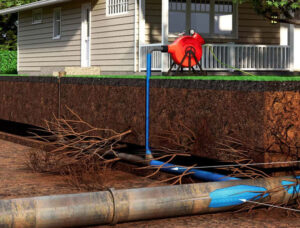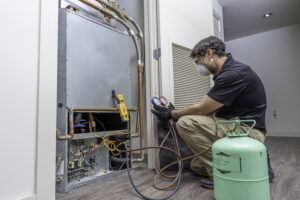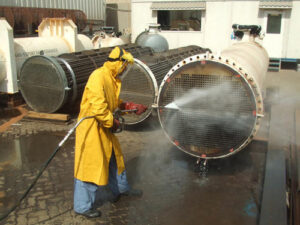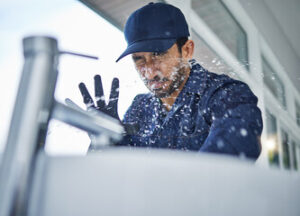When you need a sewer line repair, you must find a plumber that offers trenchless services. This process can save you time and money and is environmentally friendly.
The composite epoxy materials used in trenchless sewer repair are designed to last decades. Trenchless techniques can also be more effective than traditional digging methods. Visit Aurora CO Water Heater Repair for more information.

The cost of trenchless sewer repair depends on several factors, including the condition of the pipe and the method used. However, it’s less expensive than traditional methods and is a great option for homeowners who don’t want to damage their landscaping or property. In addition, trenchless sewer line repair is usually done faster than traditional techniques.
Before any work is started, your contractor will send a camera down into the pipes to evaluate their condition. This helps them decide which repair technique is best for your pipes. The camera lets them see any obstructions or issues with your sewer line. Once they know the condition of the pipes, they can give you an estimate of how much the job will cost.
Trenchless methods are more affordable than traditional digging methods and often take less time. Additionally, they can save you money on costs associated with restoring your lawn, driveway, and other features. This can be important if you’re selling your home or planning to build on your property in the future.
If your sewer lines are damaged, it’s important to hire a professional plumber who uses trenchless technology. Trenchless plumbing services are more efficient and less costly than traditional sewer repairs, and they can minimize damage to your yard and landscaping. Plus, they can often get the job done in a day or two, which is better for you and your family than living without any sewer services for days on end.
In most cases, the estimated cost of a trenchless sewer repair will include the cost of labor and materials. The cost of the materials depends on the type and length of your pipes. For example, copper and iron pipes are more expensive than PVC pipes. Also, longer pipes require more materials and take longer to install than shorter ones.
The labor cost will depend on the size of your pipes and whether the repairs are simple or complex. A simple repair may only involve cleaning the clogged pipes, while a more complex repair could involve replacing your entire sewer line. The estimate should also include any additional fees like permit costs or restoration costs.
If you have a broken sewer line, it is important to get the repair done as quickly as possible. Putting off the repair can lead to costly damage to your property and pose a health risk for your family. Trenchless sewer repair is an environmentally friendly and cost-effective solution to fixing damaged pipes. It allows plumbers to work without disrupting your landscape and property.
Traditional sewer repairs involve extensive excavation that can cause significant damage to your landscaping, driveways, and sidewalks. These damages can be expensive to repair and may require you to replace the affected areas of your property. Trenchless sewer repair is minimally invasive and can save you money by minimizing the time needed to complete the repair.
During the trenchless sewer line repair process, the existing pipes are cleaned with hydro and mechanical jetting to remove debris. A flexible, epoxy-saturated pipe lining is inserted into the old sewer line and left to cure. The resulting “pipe within a pipe” is a permanent solution that eliminates leaks, cracks, holes, channeling, and age-related degradation of the original pipes. It also helps prevent future problems such as root intrusion and collapsed lines.
The cured-in-place pipe can be installed in one to two days, and it’s designed to last decades. It’s a great option for damaged pipes that need to be replaced but can’t be removed because of their condition or location.
Trenchless sewer repair is eco-friendly and reduces the carbon footprint of your property. Traditional sewer repair methods generate a lot of greenhouse gases from excavation and transportation. By reducing the need for excavation, trenchless technology significantly reduces carbon emissions and helps mitigate climate change.
Because trenchless sewer repair doesn’t involve digging up your property, it is safer for you and your family. Traditional excavation can release harmful toxins into the air, potentially affecting your water supply and causing health risks. By using trenchless technology, you can avoid these toxins and protect your family’s health.
Traditionally, fixing sewer lines involved extensive digging that disrupted landscaping and property. However, trenchless repair allows experienced plumbing contractors to do the job quickly and efficiently without damaging your lawn or destroying your driveway or other fixtures. This method also helps reduce environmental concerns by limiting the amount of waste produced during the process.
Trenchless repair also helps preserve your home’s structure, which is important if you own an older house. Traditional excavation methods can cause damage to your foundation, which can lead to costly repairs down the road. Using trenchless repair methods, your plumbing contractor can save money and prevent future issues by preserving the integrity of your home’s pipes.
In addition to preventing costly damages, trenchless sewer repair is environmentally friendly. Because the procedure is minimally invasive, it avoids contaminating surrounding soil and water sources, which can occur with traditional excavation-based restorations. In addition, trenchless sewer repair helps reduce carbon emissions and promotes a greener environment.
During the repair process, your plumbing contractor will insert an inflatable tube covered in epoxy into your existing sewer line. Once the pipe liner is inserted, it will be inflated and pressed against your damaged pipes. The epoxy will cure and harden, creating a new structural pipe within your old one. The result is a unique, durable line that eliminates all leaks and cracks.
While the lining process is a great solution for homes with damaged pipes, business owners can also benefit from trenchless technology. Commercial establishments such as restaurants are prone to sewage line leaks, which can lead to business closures and fines. Trenchless technologies such as CIPP and pipe bursting are ideal for businesses because they can be completed quickly and with minimal disruption to the business.
Trenchless technology is a great option for commercial businesses because it offers many benefits that traditional excavation-based restorations cannot. It eliminates the need for digging, which can disrupt customers and employees while reducing the risk of structural damage to your building. In addition, the process is much faster and more cost-effective than conventional dig methods, saving your business time and money.
The sewer lines that run out of your home and into the city pipes are essential for waste disposal, but they can also be a huge headache if damaged or blocked. These underground plumbing lines can cause sewage backups and other problems that aren’t just frustrating and pose a health risk to you and your family. If you’re dealing with a damaged or blocked sewer line, you need to call a plumber right away so that the problem can be fixed before it gets worse.
Fortunately, today, there are new methods for repairing and replacing sewer pipes that are much less invasive than traditional dig techniques. These new trenchless technologies can improve or replace your broken sewer line without destroying your property, and they usually get the job done faster, too.
Traditional methods for repairing or replacing sewer pipes involve digging large trenches throughout your yard and property. This can destroy landscaping, driveways, and other infrastructure, costing you much money in the long run. However, with trenchless sewer repair, a technician can access your sewer line through just two small access points. This helps to save you a lot of money in both time and labor costs.
Plus, you won’t have to pay for replacing your lawn, driveway, or other infrastructure destroyed by traditional digging. This is a major benefit of trenchless sewer repair, and it’s one reason many people choose it over conventional repairs.
Other benefits of trenchless sewer repair include that it’s safer and more environmentally friendly than traditional repairs. Traditional excavation can expose you to underground toxins that can be dangerous if inhaled, and they may even seep into your water supply. Trenchless methods, on the other hand, avoid this risk by using only a camera inspection and minimal digging.
Finally, trenchless sewer repair is more durable than traditional repair methods. It uses a patented, long-lasting material that won’t crack or rust. And, because of this durability, you can get a 50-year warranty on your trenchless pipe lining. This means it’s guaranteed to last longer than the original host pipe, which can be a great peace of mind for homeowners.






